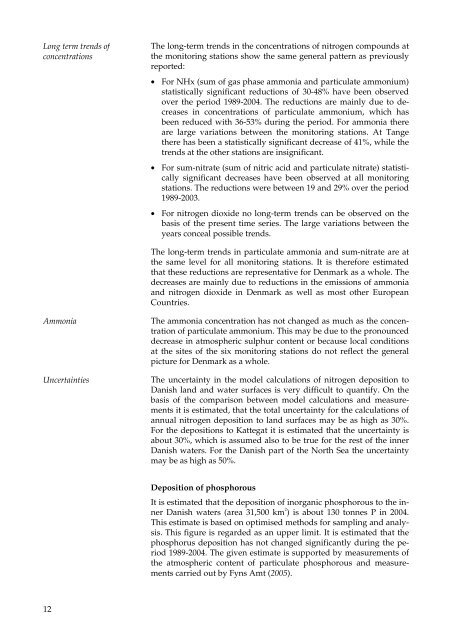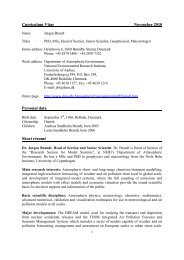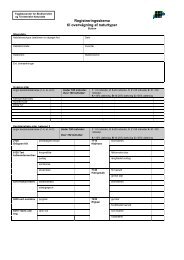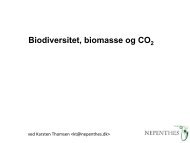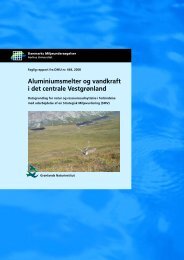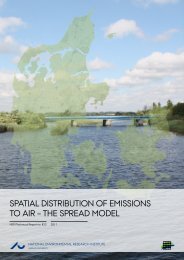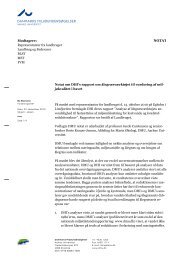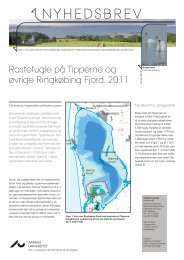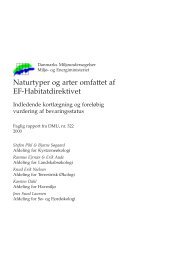Atmosfærisk deposition, driftsrapport for luft- forurening i 2004
Atmosfærisk deposition, driftsrapport for luft- forurening i 2004
Atmosfærisk deposition, driftsrapport for luft- forurening i 2004
You also want an ePaper? Increase the reach of your titles
YUMPU automatically turns print PDFs into web optimized ePapers that Google loves.
Long term trends of<br />
concentrations<br />
Ammonia<br />
Uncertainties<br />
12<br />
The long-term trends in the concentrations of nitrogen compounds at<br />
the monitoring stations show the same general pattern as previously<br />
reported:<br />
• For NHx (sum of gas phase ammonia and particulate ammonium)<br />
statistically significant reductions of 30-48% have been observed<br />
over the period 1989-<strong>2004</strong>. The reductions are mainly due to decreases<br />
in concentrations of particulate ammonium, which has<br />
been reduced with 36-53% during the period. For ammonia there<br />
are large variations between the monitoring stations. At Tange<br />
there has been a statistically significant decrease of 41%, while the<br />
trends at the other stations are insignificant.<br />
• For sum-nitrate (sum of nitric acid and particulate nitrate) statistically<br />
significant decreases have been observed at all monitoring<br />
stations. The reductions were between 19 and 29% over the period<br />
1989-2003.<br />
• For nitrogen dioxide no long-term trends can be observed on the<br />
basis of the present time series. The large variations between the<br />
years conceal possible trends.<br />
The long-term trends in particulate ammonia and sum-nitrate are at<br />
the same level <strong>for</strong> all monitoring stations. It is there<strong>for</strong>e estimated<br />
that these reductions are representative <strong>for</strong> Denmark as a whole. The<br />
decreases are mainly due to reductions in the emissions of ammonia<br />
and nitrogen dioxide in Denmark as well as most other European<br />
Countries.<br />
The ammonia concentration has not changed as much as the concentration<br />
of particulate ammonium. This may be due to the pronounced<br />
decrease in atmospheric sulphur content or because local conditions<br />
at the sites of the six monitoring stations do not reflect the general<br />
picture <strong>for</strong> Denmark as a whole.<br />
The uncertainty in the model calculations of nitrogen <strong>deposition</strong> to<br />
Danish land and water surfaces is very difficult to quantify. On the<br />
basis of the comparison between model calculations and measurements<br />
it is estimated, that the total uncertainty <strong>for</strong> the calculations of<br />
annual nitrogen <strong>deposition</strong> to land surfaces may be as high as 30%.<br />
For the <strong>deposition</strong>s to Kattegat it is estimated that the uncertainty is<br />
about 30%, which is assumed also to be true <strong>for</strong> the rest of the inner<br />
Danish waters. For the Danish part of the North Sea the uncertainty<br />
may be as high as 50%.<br />
Deposition of phosphorous<br />
It is estimated that the <strong>deposition</strong> of inorganic phosphorous to the inner<br />
Danish waters (area 31,500 km 2<br />
) is about 130 tonnes P in <strong>2004</strong>.<br />
This estimate is based on optimised methods <strong>for</strong> sampling and analysis.<br />
This figure is regarded as an upper limit. It is estimated that the<br />
phosphorus <strong>deposition</strong> has not changed significantly during the period<br />
1989-<strong>2004</strong>. The given estimate is supported by measurements of<br />
the atmospheric content of particulate phosphorous and measurements<br />
carried out by Fyns Amt (2005).


